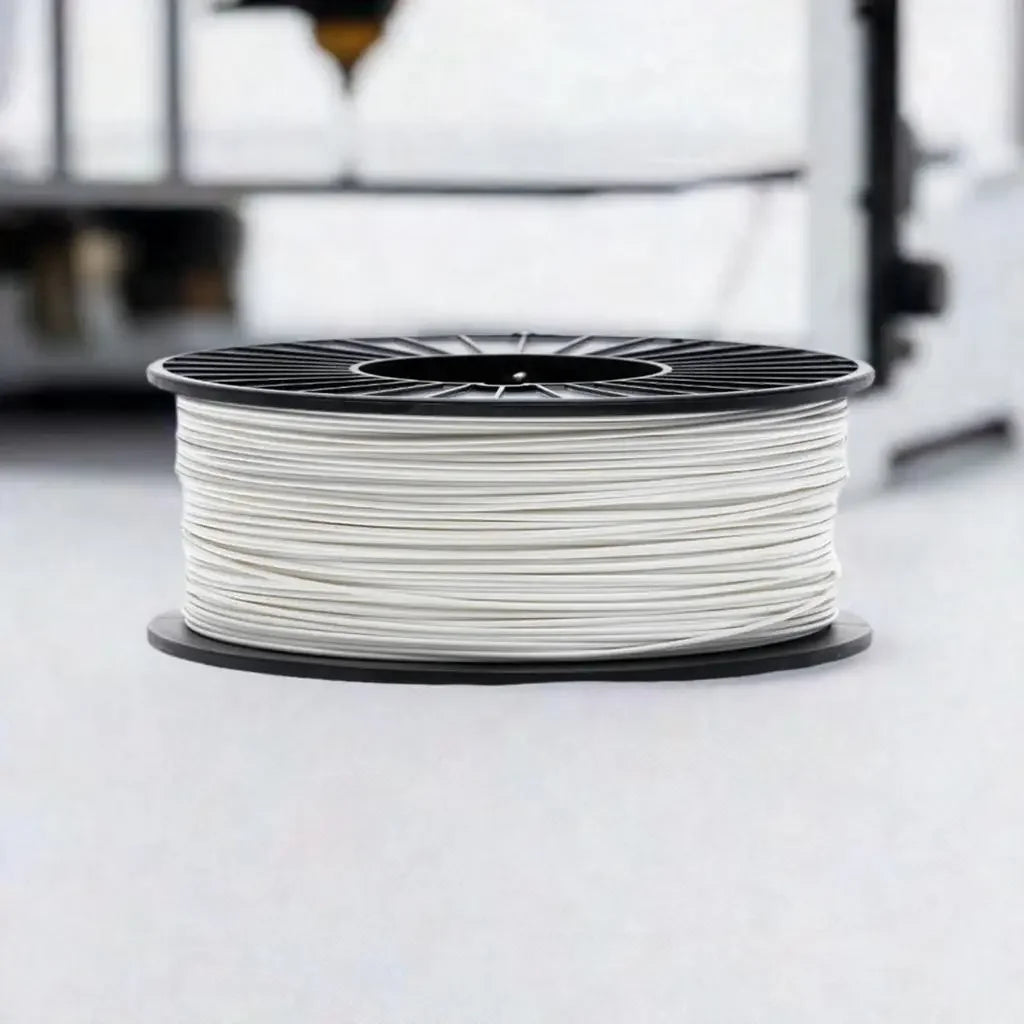

White CoexFlex™ 40D TPE
TPU-Like Flexibility, Faster Printing, Greater Strength
Experience flexible printing without the fuss. CoexFlex™ 40D TPE (TPC) delivers the same smooth, rubber-like performance you expect from TPU—but prints faster and with superior strength, heat, and chemical resistance.
With excellent layer adhesion and a soft 40D Shore hardness, it’s ideal for parts that need to flex, bend, and endure repeated use. From protective grips to seals and functional prototypes, CoexFlex™ 40D maintains durability where TPU can fall short.
Formulated from a Thermoplastic Copolyester Elastomer (TPC), it offers exceptional temperature and abrasion resistance while remaining easy to print on any TPU-capable setup.
Proudly made in the USA.
Benefits of CoexFlex™ Filament
- Excellent layer adhesion
- Great durability
- Wide range of hardness options (60A, 30D, 40D, 60D)
Uses
- Soft handles and grips
- Protective cases and skins
- Custom-shaped seals and gaskets
- Soft and flexible functional parts
Recommended Print Settings
- Hotend Temperature: 205 °C - 250 °C
- Bed Temperature: 25 °C - 85 °C
- Heated Bed Recommended
- Recommended Build Surfaces/Adhesives:
- Magigoo
- Magigoo Flex
- Painter's Tape
- Gluestick
- PEI
- Part Cooling Fan Recommended
Technical Printing Guide - COEXFLEX 40D
1. Material Notes
- Keep filament dry - store properly and dry before use
- If needed, dry at 55°C for 4 hours or more
- Preferably use direct drive extruder
- Print multiple parts sequentially to minimize stringing
- Use maximum travel speed to minimize stringing
2. Temperature Settings
Bed Temperature: 25-85°C
Extruder Temperature: 205-225°C
3. Basic Parameters
Unlike rigid filaments, TPE stretches when extruded, producing thinner lines. The line width will be smaller than the nozzle diameter. To ensure proper bonding between vertical walls and perimeters
| Nozzle | Layer Height | Line Width | Volumetric Speed | Temperature |
| 0.4mm | 0.2mm | 0.35mm | 3.2 mm³/s | 240°C |
| 0.6mm | 0.3mm | 0.55mm | 7.2 mm³/s | 242°C |
| 0.8mm | 0.4mm | 0.75mm | 12.8 mm³/s | 245°C |
| 1.0mm | 0.5mm | 0.95mm | 20.0 mm³/s | 248°C |
4. Speed Settings
0.4mm Nozzle (Volumetric Speed: 3.2 mm³/s)
| Line Type | Percentage | Speed |
| External Perimeter | 50% | 22.85 mm/s |
| Internal Perimeters | 75% | 34.27 mm/s |
| Infill | 100% | 45.7 mm/s |
| Top/Bottom | 60% | 27.42 mm/s |
| First Layer | 30% | 13.71 mm/s |
0.6mm Nozzle (Volumetric Speed: 7.2 mm³/s)
| Line Type | Percentage | Speed |
| External Perimeter | 50% | 21.80 mm/s |
| Internal Perimeters | 75% | 32.70 mm/s |
| Infill | 100% | 43.6 mm/s |
| Top/Bottom | 60% | 26.16 mm/s |
| First Layer | 30% | 13.08 mm/s |
0.8mm Nozzle (Volumetric Speed: 12.8 mm³/s)
| Line Type | Percentage | Speed |
| External Perimeter | 50% | 21.33 mm/s |
| Internal Perimeters | 75% | 32.00 mm/s |
| Infill | 100% | 42.67 mm/s |
| Top/Bottom | 60% | 25.60 mm/s |
| First Layer | 30% | 12.80 mm/s |
1.0mm Nozzle (Volumetric Speed: 20.0 mm³/s)
| Line Type | Percentage | Speed |
| External Perimeter | 50% | 21.05 mm/s |
| Internal Perimeters | 75% | 31.58 mm/s |
| Infill | 100% | 42.11 mm/s |
| Top/Bottom | 60% | 25.26 mm/s |
| First Layer | 30% | 12.63 mm/s |
5. Retraction Settings
IMPORTANT: Set travel speed to the maximum your machine allows (200-500mm/s). Faster movements reduce filament oozing time, minimizing stringing.
| Nozzle | Distance | Speed | Z-Hop |
| 0.4mm | 1.5-3.0mm | 40mm/s | 0.2mm |
| 0.6mm | 1.5-3.0mm | 40mm/s | 0.2mm |
| 0.8mm | 2.5-3.5mm | 40mm/s | 0.2mm |
| 1.0mm | 2.5-3.5mm | 40mm/s | 0.2mm |
6. Cooling Settings
Cooling Configuration:
- General: 0% (fan off)
- Force fan speed for overhangs and bridges: OFF
- Layers < 20 seconds: 40% fan
- First layer: 0%
7. Troubleshooting Guide
| Problem | Solution |
| Irregular extrusion |
1. Dry the filament 2. Check extruder 3. Reduce speed |
| Poor adhesion |
1. Dry the filament 2. Use adhesive 3. Adjust first layer |
| Stringing |
1. Dry the filament 2. Adjust retraction 3. Increase travel speed 4. Check temperature |
PLEASE NOTE: These printing parameters are initial recommendations based on our experience. They may need adjustment depending on your specific 3D printer, environmental conditions, and the geometry of the part you are printing. Use these settings as a starting point and fine-tune them according to your specific needs.
CX18 CoexFlex TPE 40D Technical Data Sheet
Technical Data Sheet: CX18 COEX-FLEX TPE 40D SERIES 3D PRINTING FILAMENT
TDS Rev 1.0
BASE RESIN: DuPont Hytrel
Physical Properties
| Property | Standard | Unit | Typical Value |
|---|---|---|---|
| Specific Gravity - Density | ISO 1183 | g/cm³ | 1.16 |
| Melting Temperature, 10°C/min | ISO 11357-1/-3 | °C | 150 |
| Vicat Softening Temp, 50°C/h, 10N | ISO 306 | °C | 105 |
| Hardness, Shore D (max) | ISO 868 | - | 40 |
Mechanical Properties
| Property | Standard | Unit | Typical Value |
|---|---|---|---|
| Tensile Stress @ Break FLAT / VERT. | ISO 527 Type 1BA | MPa | 19 / 13 |
| Tensile Modulus | ISO 527 Type 1A | MPa | 50.0 |
| Nominal Strain @ Break FLAT / VERT. | ISO 527 Type 1BA | % | ≥ 500 / ≥ 300 |
| Tensile Stress @ 50% | ISO 527 Type 1BA | MPa | 7 |
| Notched & Unnotched Izod Impact | ISO 180/1A | J/m | No Break |
| Shrinkage Rate < 0.5% | ISO 294-4 | mm/mm | 0.20 - 0.40% |
Thermal Properties
| Property | Standard | Unit | Typical Value |
|---|---|---|---|
| Glass Transition Temperature (Tg) | ISO 11357-2 | °C | -50.0 |
| Melt Temperature | - | °C | 152 |
| Drying Temperature @ 3 hours | - | °C | 80 |
SPECIFICATIONS
| Filament Size: | 1.75mm | (in) | 2.85mm | (in) |
|---|---|---|---|---|
| MIN Diameter: | 1.72mm | 0.0677 in | 2.79mm | 0.1098 in |
| MAX Diameter: | 1.78mm | 0.0701 in | 2.91mm | 0.1146 in |
| Tolerance | +/- .03mm | +/- 0.0012 in | +/- .06mm | +/- 0.0024 in |
ADVANTAGES
- Resilient, Flexible, Heat Resistant, Chemical Resistant, Strong, Durable
- Contains up to 60% renewably sourced materials from biomass
- Combines the flexibility of rubber with the strength and processability of thermoplastics
Printed Specimen Conditions
| Printer: | Open Source FDM/FFF |
| Nozzle: | 0.4mm |
| Layer Height: | 0.25mm |
| Infill: | 100%, +/-45° |
| Extrusion Temp: | 205 - 250°C |
| Bed Temp: | 40°C |
| Specimen Orientation: | XY Flat and Vertical |
| Printing Speed | 15mm/sec.. |
Disclaimer: The technical data contained on this data sheet is furnished without charge or obligation and accepted at the recipient's sole risk. This data should not be used to establish specifications limits or used alone as the basis of design. The data provided is not intended to substitute any testing that may be required to determine fitness for any specific use.
CX18 CoexFlex TPE 40D Safety Data Sheet
Material Safety Data Sheet: CX18 TPE 40D SERIES 3D PRINTING FILAMENT
MSDS Rev 1.0
BASE RESIN: Dupont™ Hytrel PD405610
1. Identification of the substance/preparation and of the company
660 Corporate WAY
Pulaski, WI 54162
Phone: (920) 757-1055
2. Hazards identification
3. Composition / information on ingredients
3.1 Chemical characteristics:
This product does not contain any components that require disclosure according to OSHA Hazard Communication Standard 2012.
4. First-aid measures
5. Fire-fighting measures
6. Accidental release measures
7. Handling and storage
8. Exposure controls/ personal protection
9. Physical and chemical properties
10. Stability and reactivity
11. Toxicological information
12. Ecological information
13. Disposal considerations
14. Transport information
15. Regulatory information
15.1 EPA regulations:
Sara 313 title III: This material does not contain any chemical components with known CAS numbers that exceed the threshold (De Minimis) reporting levels established by SARA Title III, Section 313.
TSCA Inventory List: In compliance with TSCA Inventory requirements for commercial purposes.
16. Other information
This data is based on the current state of our information and experience. This safety data sheet describes our product in terms of safety requirements. Preceding data is not applicable as a warranty of product properties. It is the responsibility of the recipient to observe the existing legal regulations for the use of this product.
Disclaimer: The safety data contained on this data sheet is furnished without charge or obligation and accepted at the recipient's sole risk. This data describes our product in terms of safety requirements. The data provided is not applicable as a warranty of product properties. It is the responsibility of the recipient to observe the existing legal regulations for the use of this product.



